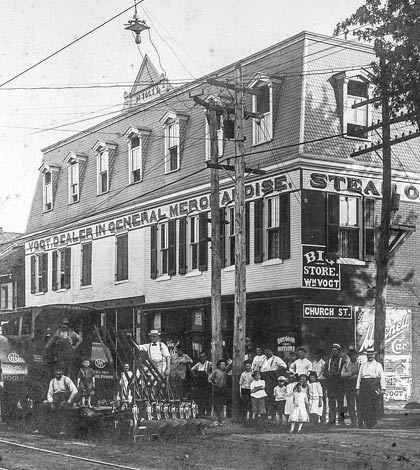County begins to take shape entering 20th Century

The Vogt Store opened in 1893 on Main Street in Columbia, offering virtually everything from farm machinery to groceries. It was also home to the community’s first elevator. Electric street lights that came to Columbia in 1879 are seen at the top.
This is the next monthly installment of our series looking into the 200-year history ofMonroe County in honor of its Bicentennial. This article examines the years 1880-1900.
The two decades from 1880 to the beginning of the 20th Century saw many changes in Monroe County, some of which are still with us today.
In 1881, the beautiful old Maeystown stone bridge, which is still used daily by people and vehicles passing through the historic village, was placed in use. It remains in superb shape today as it celebrates 135 years of service.
Seven years later, in 1888, Waterloo was officially incorporated as a city.
In 1892, Monroe County officials decided the county needed its own official seal – the device that is used to “seal,” or certify a document. In those days, people of importance usually had their own personal seals, and county officials were required to use their own seals to make the raised circular markings on official documents. The original seal was a circular design including a plow, a rake and a scythe. That has come down to today’s county seal that includes a plow and wheat stalk.
In 1893, the precursor to today’s shopping malls – the Vogt Store – was built in Columbia at 107-109 Main Street. The intersection in those days was called Church Street. Today, it is West Kunz Street.
You could buy just about anything at the Vogt Store – from groceries to dry goods — and as the Monroe County Bicentennial calendar states, “needles to threshing machines.”
The building also featured Columbia’s first elevator. It was not for passengers, however. It served instead to take goods to and from the store room on the building’s third floor. Restored beautifully, the building remains a distinct feature of historic downtown Columbia today.
Moving east in the county, the village of Hecker was officially established in 1895. The community was known as Freedom at that time, but the U.S. Postal Service noted to village fathers that Illinois already had another community named Freedom and demanded a different name.
So, the name “Hecker” was designated, honoring a well-known farmer, Col. Friedrich Franz Karl Hecker, whose farm was nearby in St. Clair County.
The year 1895 was also the establishing date for what was originally called the Farmers Fountain Creamery Organization in Waterloo. Operating under that name, and later Waterloo Milk Company and Waterloo Condensed Milk Company, the firm employed a large number of citizens and was a place where farmers worked together to market dairy products produced locally throughout the region.
In 1896, the round dance pavilion was built in Metter Park in Columbia. It continues to serve the community as a popular summer gathering place today.
Monroe County’s population, which had climbed to 13,682 in 1880, actually fell by more than 700 to 12,948 in 1890, before recovering and achieving a census figure of 13,847 in 1900.
Asked why rapid growth of previous decades turned around, Monroe County Clerk Dennis Knobloch, whose office maintains the records of births, deaths, marriages and other official happenings, said there were considerable losses due to diseases in those times.
“It is difficult to look at half a dozen death certificates from those days without finding one or more attributed to smallpox or diphtheria,” he said.
A combination of medical advances and understanding the value of better cleanliness eventually brought both diseases under control as Monroe Countians entered the next century.








